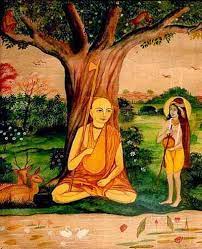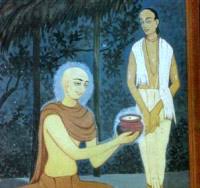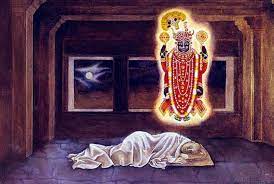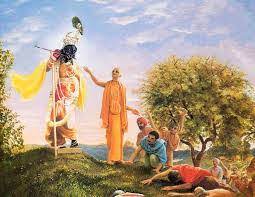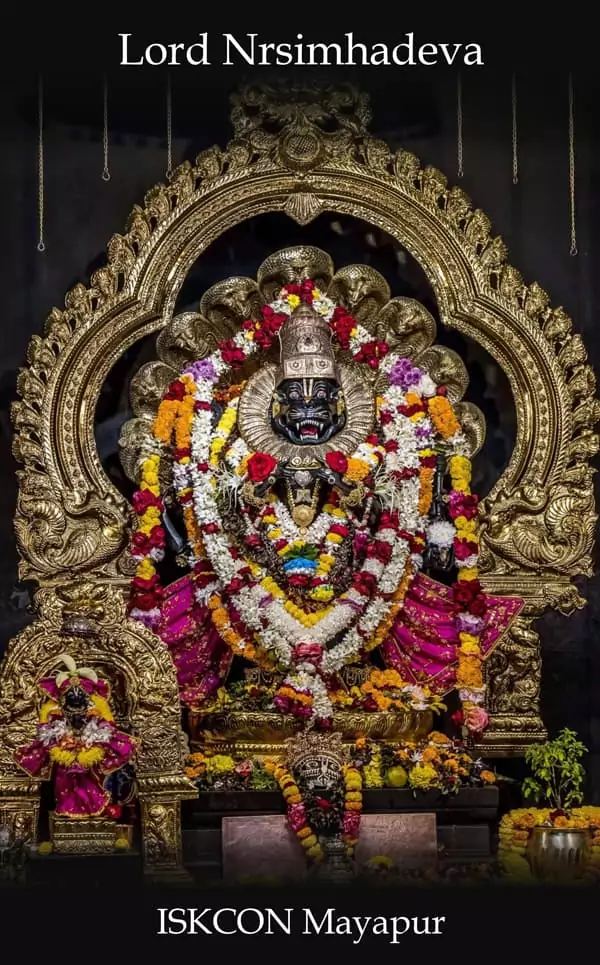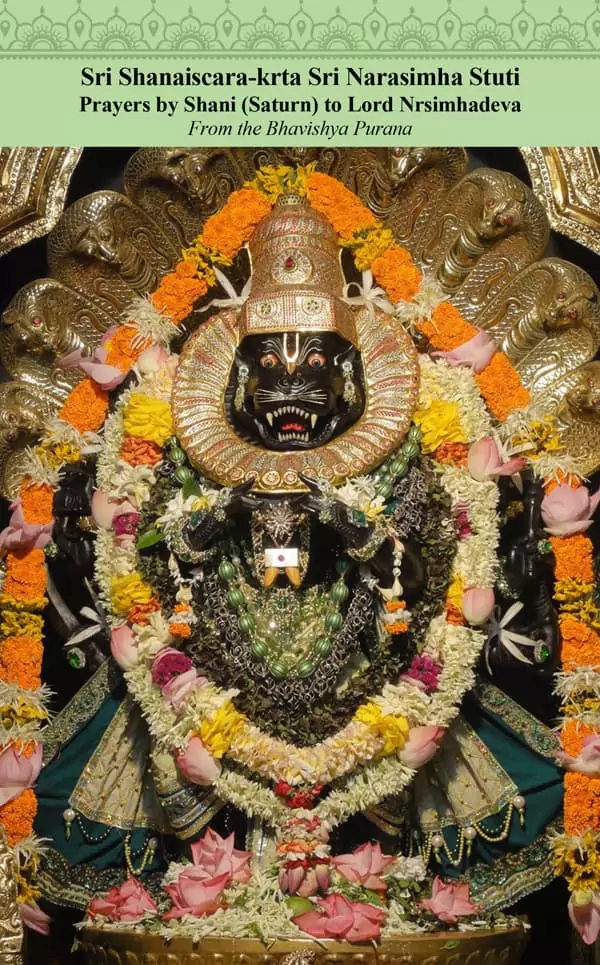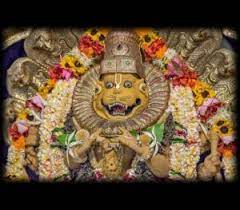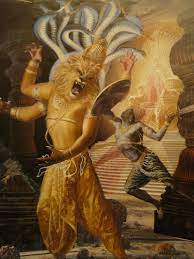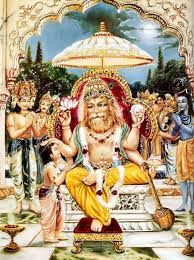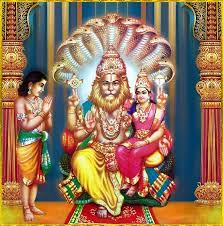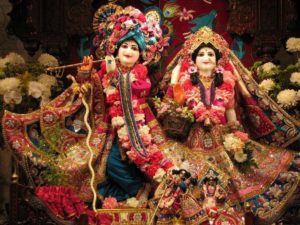 We shall read from Srimad-Bhagavatam, Canto Five, Chapter Eighteen: “The Residents of Jambudvipa Offer Prayers,” from the series of prayers recited by Prahlada Maharaja to Lord Nrsimhadeva. Text 8 is a very important prayer, or mantra, and in it many words are repeated, which gives them great emphasis.
We shall read from Srimad-Bhagavatam, Canto Five, Chapter Eighteen: “The Residents of Jambudvipa Offer Prayers,” from the series of prayers recited by Prahlada Maharaja to Lord Nrsimhadeva. Text 8 is a very important prayer, or mantra, and in it many words are repeated, which gives them great emphasis.
TEXT 8
om namo bhagavate narasimhaya namas tejas-tejase avir-avirbhava vajra-nakha vajra-damstra karmasayan randhaya randhaya tamo grasa grasa om svaha; abhayam abhayam atmani bhuyistha om ksraum.
TRANSLATION
I offer my respectful obeisances unto Lord Nrsimhadeva, the source of all power. O my Lord who possess nails and teeth just like thunderbolts, kindly vanquish our demonlike desires for fruitive activity in this material world. Please appear in our hearts and drive away our ignorance so that by Your mercy we may become fearless in the struggle for existence in this material world.
TEXT 9
svasty astu visvasya khalah prasidatam
dhyayantu bhutani sivam mitho dhiya
manas ca bhadram bhajatad adhoksaje
avesyatam no matir apy ahaituki
TRANSLATION
May there be good fortune throughout the universe, and may all envious persons be pacified. May all living entities become calm by practicing bhakti-yoga, for by accepting devotional service they will think of each other’s welfare. Therefore let us all engage in the service of the supreme transcendence, Lord Sri Krsna, and always remain absorbed in thought of Him.
PURPORT by Srila Prabhupada
The following verse describes a Vaisnava:
vancha-kalpa-tarubhyas ca
krpa-sindhubhya eva ca
patitanam pavanebhyo
vaisnavebhyo namo namah
Just like a desire tree, a Vaisnava can fulfill all the desires of anyone who takes shelter of his lotus feet. Prahlada Maharaja is a typical Vaisnava. He prays not for himself, but for all living entities—the gentle, the envious, and the mischievous. He always thought of the welfare of mischievous persons like his father, Hiranyakasipu. Prahlada Maharaja did not ask for anything for himself; rather, he prayed for the Lord to excuse his demoniac father. This is the attitude of a Vaisnava, who always thinks of the welfare of the entire universe.
Srimad-Bhagavatam and bhagavata-dharma are meant for persons who are completely free of envy (parama-nirmatsaranam). Therefore Prahlada Maharaja prays in this verse, khalah prasidatam: “May all the envious persons be pacified.” The material world is full of envious persons, but if one frees himself of envy, he becomes liberal in his social dealings and can think of others’ welfare. Anyone who takes up Krsna consciousness and engages himself completely in the service of the Lord cleanses his mind of all envy (manas ca bhadram bhajatad adhoksaje). Therefore we should pray to Lord Nrsimhadeva to sit in our hearts. We should pray, bahir nrsimho hrdaye nrsimhah: “Let Lord Nrsimhadeva sit in the core of my heart, killing all my bad propensities. Let my mind become clean so that I may peacefully worship the Lord and bring peace to the entire world.”
Srila Visvanatha Cakravarti Thakura has given us a very fine purport in this regard. Whenever one offers a prayer to the Supreme Personality of Godhead, one always requests some benediction from Him. Even pure (niskama) devotees pray for some benediction, as instructed by Lord Sri Caitanya Mahaprabhu in His Siksastaka:
ayi nanda-tanuja kinkaram
patitam mam visame bhavambudhau
krpaya tava pada-pankaja-
sthita-dhuli-sadrsam vicintaya
“O son of Maharaja Nanda [Krsna], I am Your eternal servitor, yet somehow or other I have fallen into the ocean of birth and death. Please pick Me up from the ocean of death and place Me as one of the atoms at Your lotus feet.” In another prayer Lord Caitanya says, mama janmani janmanisvare bhavatad bhaktir ahaituki tvayi: “Life after life, kindly let Me have unalloyed love and devotion at Your Lordship’s lotus feet.” When Prahlada Maharaja chants om namo bhagavate narasimhaya, he prays for a benediction from the Lord, but because he is also an exalted Vaisnava, he wants nothing for his personal sense gratification. The first desire expressed in his prayer is svasty astu visvasya: “Let there be good fortune throughout the entire universe.” Prahlada Maharaja thus requested the Lord to be merciful to everyone, including his father, a most envious person. According to Canakya Pandita, there are two kinds of envious living entities: one is a snake, and the other is the man like Hiranyakasipu, who is by nature envious of everyone, even of his father or son. Hiranyakasipu was envious of his little son Prahlada, but Prahlada Maharaja asked a benediction for the benefit of his father. Hiranyakasipu was very envious of devotees, but Prahlada wished that his father and other demons like him would give up their envious nature by the grace of the Lord and stop harassing the devotees (khalah prasidatam). The difficulty is that the khala (envious living entity) is rarely pacified. One kind of khala, the snake, can be pacified simply by mantras or by the action of a particular herb (mantrausadhi-vasah sarpah khalakena nivaryate). An envious person, however, cannot be pacified by any means. Therefore Prahlada Maharaja prays that all envious persons may undergo a change of heart and think of the welfare of others.
If the Krsna consciousness movement spreads all over the world, and if by the grace of Krsna everyone accepts it, the thinking of envious people will change. Everyone will think of the welfare of others. Therefore Prahlada Maharaja prays, sivam mitho dhiya. In material activities, everyone is envious of others, but in Krsna consciousness, no one is envious of anyone else; everyone thinks of the welfare of others. Therefore Prahlada Maharaja prays that everyone’s mind may become gentle by being fixed at the lotus feet of Krsna (bhajatad adhoksaje). As indicated elsewhere in Srimad-Bhagavatam (sa vai manah krsna-padaravindayoh) and as advised by Lord Krsna in Bhagavad-gita (18.65), man-mana bhava mad-bhaktah, one should constantly think of the lotus feet of Lord Krsna. Then one’s mind will certainly be cleansed (ceto-darpana-marjanam [Cc Antya 20.12]). Materialists always think of sense gratification, but Prahlada Maharaja prays that the Lord’s mercy will change their minds and they will stop thinking of sense gratification. If they think of Krsna always, everything will be all right. Some people argue that if everyone thought of Krsna in that way, the whole universe would be vacated because everyone would go back home, back to Godhead. However, Srila Visvanatha Cakravarti Thakura says that this is impossible because the living entities are innumerable. If one set of living entities is actually delivered by the Krsna consciousness movement, another set will fill the entire universe.
COMMENT by Giriraj Swami
vancha-kalpatarubhyas ca
krpa-sindhubhya eva ca
patitanam pavanebhyo
vaisnavebhyo namo namah
Srila Prabhupada quoted this verse in the purport because it describes a Vaishnava and because Prahlada Maharaja, who recited the prayers that we are reading and discussing, is an excellent example of a Vaishnava.
Hiranyakasipu, the father of Prahlada, was a great demon, and he performed such severe austerities that the entire universe became disturbed. Eventually, Lord Brahma went to Hiranyakasipu personally to ask him what benediction he wanted, so that he would cease his austerities and stop the disturbance within the universe. Hiranyakasipu asked for the benediction to become immortal, but Lord Brahma replied, “I myself am not immortal.” So Hiranyakasipu asked for various boons that he thought would indirectly make him immortal. He asked that he not be killed inside a building or outside; that he not be killed in the day or at night; that he not be killed on the land or in the sky; that he not be killed by any human being or animal, demigod or demon, or any other creature; and that he not be killed by any weapon. He asked for such benedictions that he thought would make him immortal and give him absolute supremacy in the universe. And Lord Brahma agreed to all of the requests: “So be it.”
In due course, Hiranyakasipu had a son named Prahlada, and Prahlada was a devotee. Earlier, the Lord in the form of Varahadeva had killed Hiranyakasipu’s brother Hiranyaksa, and Hiranyakasipu was determined to avenge his brother’s death—he actually thought that he could kill Vishnu. He knew that Vishnu had appeared as Varaha and killed Hiranyaksa. Later, Diti, the mother of Hiranyaksa and Hiranyakasipu, desired a son who would kill Indra, because she thought that Indra, with the help of Vishnu, was responsible for the death of her sons.
We know from scripture—sadhu-sastra-guru-vakya—that Vishnu is God. So we might consider, “How could anyone imagine that they could kill God?” But if God came into this room and we didn’t recognize Him by the features that are described in the scriptures, we wouldn’t know that He was God, because God looks like a human being. As the Bible says, “God created man in His own image.” God has arms and legs and hands and feet and eyes and ears and a nose and mouth and all the different bodily features we have. His body looks like ours. What distinguishes Him from us is that He has immeasurable potencies. For example, the president of the United States looks like a human being like the rest of us, but he has immense powers (more than some might like). If he wants, he can order the army to invade a country or send the police to arrest a citizen. He looks like us, but we don’t have that power. We might want to do certain things, but we don’t have the power. He has the power. Still, he looks like one of us.
When someone performs great austerities, he can get great powers. Even demons, if they perform the required austerities, can become very powerful and attain various mystic perfections. So, although Lord Vishnu has all power and mystic potency, demons can also get powers. And Hiranyakasipu thought that by his austerities and the powers he derived from them and the benedictions he got from Lord Brahma, he could become immortal and conquer the universe. He had created a great disturbance in the universe by performing severe austerities; now he did so by waging war against the demigods and conquering their territories.
Although he was a demon, Hiranyakasipu had natural affection for his son, and he wanted him to be like his father, a great materialist, and had him educated accordingly. He engaged teachers to instruct the boy to be expert in politics and diplomacy. And as parents sometimes ask their children, “What did you learn in school today? What is your favorite subject?” Hiranyakasipu asked Prahlada, “What is the best thing you have learned?” He thought Prahlada would say something cute, something sweet. But Prahlada gave what was for Hiranyakasipu the worst answer imaginable. He said, “The best thing I have learned is sravanam kirtanam visnoh smaranam pada-sevanam/ arcanam vandanam dasyam sakhyam atma-nivedanam”—to hear about and glorify Vishnu. Vishnu, whom Hiranyakasipu considered to be his worst enemy. So, Hiranyakasipu became furious, and when nothing else worked, he decided to kill Prahlada. He applied the logic that if a part of your body becomes infected, the disease may spread throughout the body and kill you, so even though it is part of your body, you have to amputate it, for the sake of the rest of the body. He thought, “Although Prahlada is my son, he has been infected by the disease of Vaishnavism and we have to cut him out before the disease spreads and finishes us.”
Hiranyakasipu tried to kill Prahlada in so many ways. He had conquered the demigods, and he occupied the throne of King Indra and ruled over the inhabitants of all the other planets. Except for Brahma and Shiva, all the demigods were engaged in his service, offering him obeisances and praise. He was so powerful. But he could not kill Prahlada. He had horrible demons try to pierce Prahlada’s body with tridents. He threw Prahlada beneath the feet of elephants and in the midst of venomous snakes. But no matter what he did, he could not kill him. He hurled him from a mountain top, gave him poison, starved him, and threw heavy stones on him to crush him. Nothing worked—nothing affected Prahlada in the least. Hiranyakasipu was astonished. He had triumphed over the armies of the demigods, but he could not subdue his five-year-old son.
Finally, after all his efforts had failed, Hiranyakasipu asked Prahlada, “From where do you get your power? You know that when I am angry all the planets of the three worlds, along with their rulers, tremble. But you have no fear, and you have exceeded my power to control you. From where do you get your strength?” And Prahlada replied, “I get my strength from the same source as you, from the source of all strength—from God.” Now, that really infuriated Hiranyakasipu, because he thought that he was the source of his own power. That is the demoniac mentality: we think we are the doers—kartaham iti manyate. We think, isvaro ’ham aham bhogi siddho ’ham balavan sukhi: “I am the controller. I am the enjoyer. I am perfect and powerful and happy.” Hiranyakasipu didn’t want to hear that he got his power from someone else—least of all from the person to whom Prahlada referred: the unlimited Supreme Lord.
Thus Hiranyakasipu became even more infuriated and more defiant. He said to Prahlada, “If this God of yours is everywhere, why is He not present before me in this pillar? I am going to kill you now, and let us see this God of yours protect you!” Filled with rage, Hiranyakasipu rose from his throne and with great anger struck his fist against the column. And out of the pillar emerged the wonderful form of Nrsimhadeva. Nrsimha Bhagavan ki jaya!
Nrsimhadeva is unique. He is neither a man nor an animal but has a form that is half lion and half man. And His appearance fulfilled all the conditions of Lord Brahma. He isn’t a demigod or human being or animal—He isn’t any creature. Ultimately He picked up Hiranyakasipu and placed him on His lap and with His long, sharp nails ripped apart his chest. Hiranyakasipu was extraordinarily powerful, and his chest could withstand the thunderbolt of Indra. No one could pierce his body. He was so powerful. One could throw arrows and all types of weapons at him, and they would bounce off him like nothing. So it was no mean feat to tear open his chest. Yet Nrsimhadeva ripped open his chest with His nails, tore out his heart, and thus killed this great demon.
We glorify Lord Nrsimha daily with the prayer (a line of which Srila Prabhupada quoted in his purport):
ito nrsimhah parato nrsimho
yato yato yami tato nrsimhah
bahir nrsimho hrdaye nrsimho
nrsimham adim saranam prapadye
Ito nrsimhah means “Nrsimha is here”; parato nrsimho means “Nrismha is also there.” Yato yato yami tato nrsimhah: “Wherever I go, there is Nrsimha.” Bahir nrsimho: “Nrimsha is outside”; hrdaye nrsimho: “Nrsimha is in my heart.” Nrsimham adim saranam prapadye: “I surrender to Lord Nrsimha, the origin of all and the supreme shelter.” He is everywhere.
We also sing:
namas te nara-simhaya
prahladahlada-dayine
hiranyakasipor vaksah-
sila-tanka-nakhalaye
Sila-tanka-nakhalaye. Sila means “stone,” as in saligrama-sila; nakha means “fingernails”; and tanka means “chisel.” If you want to break a hard stone, you have to chisel it. And Lord Nrsimha’s nails were like chisels that cut the chest of Hiranyakasipu—his stonelike heart and chest.
Hiranyakasipu thought that he could become immortal by his own power and intelligence. But his intelligence was not as great as that of Lord Nrsimha, who kept all of Brahma’s boons intact and still was able to kill the demon. Nrsimhadeva assumed this wonderful form—adbhuta means “wonderful”—that was half man and half lion. He sat at the threshold of the palace, which wasn’t inside or outside. He appeared at twilight, which was neither day nor night. And He killed Hiranyakasipu on His lap—not in the sky or on the land. And not with any weapon but with His nails. He kept all the benedictions intact and still killed him.
Srila Prabhupada explains that however intelligent we are, Krishna is always more intelligent. Mother Yasoda tried to bind Krishna with ropes, but no matter how many ropes she tied together, He was always two fingers bigger; she was always just a little short. In the same way, if we try to compete with God—try to outwit God, try to cheat God—we will always fall short. Srila Prabhupada says, “Hiranyakasipu was thinking only of the atomic bomb, how to protect himself from the bomb, but he forgot about the nails.” He made so many arrangements to protect himself, but he neglected to consider the nails. So, the conclusion should be “If you can’t fight Him, join Him.” Nrsimham adim saranam prapadye. Just surrender to Nrsimhadeva. Don’t try to compete with Him or fight with Him. That is the background of Prahlada’s prayers.
After Nrsimhadeva killed Hiranyakasipu, He asked Prahlada to accept some benediction, but Prahlada was a pure devotee—he didn’t want any material benediction. In today’s verse we find the word ahaituki: without any motive. Prahlada had no material motive, so when Lord Nrsimhadeva asked him to accept some benediction, he refused. He said, “Why are You trying to tempt me with material allurements? If I were to desire material benefit in exchange for devotional service, I wouldn’t be a servant. I would be like a businessman who wants profit in exchange for service. Lord, I am Your eternal servant, and You are my eternal master. We have no other relationship.” Prahlada asked only that there be no material desires within his heart.
But Nrsimhadeva insisted that Prahlada accept some benediction, and in the end Prahlada agreed: “If You really want me to ask something of You, then I ask that You purify my father.” This shows the exemplary character of Prahlada, who, as Srila Prabhupada said, is a typical Vaishnava. A Vaishnava is the friend of everyone, of all living entities (suhrdah sarva-dehinam). He never becomes the enemy of his enemy. He remains ever the friend of everyone—even his enemies. So even though Hiranyakasipu was so envious—even of his own son—that he tried in so many ways to kill him, Prahlada remained true to his character as a Vaishnava. He thought of his father’s welfare, and he wished his father well.
In this prayer to Lord Nrsimha, Prahlada is praying for his father and for all envious people, that they may be pacified. Khalah prasidatam: “May all envious persons be pacified.” As Srila Prabhupada notes, almost everyone is envious. In fact, we come into this material world because we are envious of Krishna. That is why we are here. Thus Srila Prabhupada says, “Almost everyone.” The only exceptions are pure devotees. Everyone else has some envy. It is like saying, “Almost everyone in the prison is a criminal.” Yes, in principle, all the prisoners are criminals. There may be some staff members who are not, who are there to minister to the inmates, but the prisoners themselves are criminals. So, other than the devotees who are working for the welfare of the fallen souls, everyone is envious. And no one is spared their envy. Hiranyakasipu was envious of his five-year-old son, a pure devotee. Diti was envious of her nephew Indra. She wanted to kill him, or get him killed. No one is spared.
If we want to get out of the bondage of material existence, we have to become free from envy. And how do we become free from envy? By the process of Krishna consciousness. And that is Prahlada’s prayer: bhajatad adhoksaje. Bhaja means to worship and serve. The word bhakti comes from the verbal root bhaj: to serve with devotion. Serve whom? Adhoksaja: Krishna, who is beyond material sense perception. Hiranyakasipu couldn’t see Vishnu; the Lord was beyond his sense perception. It was only when He chose to appear to him by emerging from the pillar as Nrsimhadeva that Hiranyakasipu could see Him. Otherwise, only pure devotees can see Krishna—no one else. He is beyond the perception of the materially contaminated senses, mind, and intelligence of the conditioned souls.
The process is Krishna consciousness (bhajatad adhoksaje), and as Prahlada has explained, we engage in devotional service in Krishna consciousness by sravanam kirtanam visnoh smaranam: hearing and chanting about Vishnu and remembering Him. As Srila Prabhupada quoted from the Siksastaka, ceto-darpana-marjanam: sankirtana, the chanting of the holy names of the Lord, cleanses the heart. That is the process. And when the heart is cleansed, we become peaceful and calm (bhadram).
This process is described in two important verses from the second chapter of Srimad-Bhagavatam:
srnvatam sva-kathah krsnah
punya-sravana-kirtanah
hrdy antah-stho hy abhadrani
vidhunoti suhrt satam
“Sri Krsna, the Personality of Godhead, who is the Paramatma [Supersoul] in everyone’s heart and the benefactor of the truthful devotee, cleanses desire for material enjoyment from the heart of the devotee who has developed the urge to hear His messages, which are in themselves virtuous when properly heard and chanted.” (SB 1.2.17)
Srnvatam sva-kathah krsnah. When we hear krsna-katha, all the abhadrani—all the material desires, all the disturbances within the heart—are cleansed by the Lord Himself, who is sitting within the heart as the well-wishing friend of the truthful devotee (vidhunoti suhrt satam).
And the transcendental sound itself is Krishna. Krishna enters the ear in the form of transcendental sound, and when we are hearing properly, the sound will enter the heart and cleanse it. Krishna in the form of transcendental sound will cleanse the dirty things in the heart (ceto-darpana-marjanam).
The next verse explains further:
nasta-prayesv abhadresu
nityam bhagavata-sevaya
bhagavaty uttama-sloke
bhaktir bhavati naisthiki
“By regular attendance in classes on the Bhagavatam and by rendering of service to the pure devotee, all that is troublesome to the heart is almost completely destroyed, and loving service unto the Personality of Godhead, who is praised with transcendental songs, is established as an irrevocable fact.” (SB 1.2.18)
Bhagavata-sevaya: by serving the person Bhagavata or by serving the book Bhagavata, all that is troublesome to the heart—the same word, abhadrani (abhadra, nasta-prayesv abhadresu)—all that is troublesome, all that is disturbing to the heart, becomes destroyed almost to nil at this stage. So when Prahlada prays that envious persons be pacified (bhadram), he is praying that all the abhadra, the disturbing things, the material desires within the heart, be removed. And the way they can be removed is by Krishna consciousness, by absorbing the mind in Krishna. That process is recommended in the Bhagavad-gita (man-mana bhava mad-bhakto) and in Srimad-Bhagavatam (sa vai manah krsna-padaravindayoh)—to absorb the mind in Krishna. That is Krishna consciousness, and that will cleanse the heart and make us calm and peaceful. Then, instead of being envious of others and wanting to exploit and dominate them, we will think of their welfare. We want to help them and encourage them in Krishna consciousness.
Our main process, specially given to us in Kali-yuga by Sri Chaitanya Mahaprabhu, is sankirtana, the chanting of the holy names of the Lord. But we have to do it in such a way that our minds are absorbed. That is Prahlada’s prayer, that our minds be absorbed in Krishna. So, when we chant, we want to hear—we want our minds to be absorbed in the sound of Lord Krishna’s holy name. But when we try practically, what do we find? Is our mind peaceful? Is it absorbed in Krishna’s holy name? Or is it wandering here and there, thinking of different things to control and enjoy, which suggests the mentality described in the Bhagavad-gita and ascribed to demons: isvaro ’ham aham bhogi—“I am the controller; I am the enjoyer”? When we analyze the thoughts we have even while we are chanting—while we are supposed to be chanting and hearing—we find that the underlying principles are “I am the enjoyer; I am the controller.” We are chanting, but we are distracted, thinking, “Oh, I have to do this. I have to do that.” What does that imply? That I think I am the controller. “I have to control all these things. I can’t hear Krishna’s name. I have to control all these things.” And why do we want to control them? Though we may also want to control for Krishna’s service, the tendency is to control for sense gratification. We want to control people and events in certain ways as to make our lives more pleasurable. We want to make arrangements to make our lives more pleasant.
This demoniac tendency that we discussed in relation to Hiranyakasipu is there in us too. As our godbrother Ravindra Svarupa Prabhu often quotes, “We have seen the enemy, and he is us.” We are the enemy. It is not out there. We are the enemy—our own bad propensities, our own uncontrolled minds and senses. The problem is not out there. It is right here inside us.
So, we have to work hard. We have to endeavor to chant and hear with attention, with feeling. Whenever the mind wanders, we have to bring it back to the sound of Lord Krishna’s holy name. And that is a difficult job. In fact, it is a futile exercise on our own strength alone. We need help. We need mercy. We need mercy from Krishna. And Prahlada is helping us. We should be praying, but he is leading us in the prayer. In Text 8 he prayed to Lord Nrsimhadeva in the heart, “Kindly vanquish my demonlike desires. Just as You destroyed Hiranyakasipu, kindly destroy my demonlike desires, kill my bad propensities, and sit on the throne of my heart.”
So, we do both: we make our own effort, and we pray for mercy. And when the Lord sees that we are making an honest effort, He is inclined to give His mercy. We don’t just sit back and do nothing and pray for mercy. We have to make an effort. But at the same time, we understand that we cannot be successful by our effort alone; we need the Lord’s help. And when the Lord sees our genuine, sincere, tireless effort, He will be merciful. Mother Yasoda couldn’t bind Krishna with all the ropes in Vraja, but when Krishna saw her tireless effort to bind Him, He felt compassion for her and allowed her to bind Him. Our acharyas explain that that gap of two fingers by which the ropes were always too short can be covered (1) by our endeavor, our hard labor (parisrama), and (2) by Krishna’s mercy (krsna-krpa). These two elements can cover that distance and make our efforts successful—by Krishna’s grace.
Srila Visvanatha Cakravarti Thakura, as quoted by Prabhupada in the purport, explains that whenever a devotee offers a prayer to the Lord, he asks for some benediction. Om namo bhagavate narasimhaya is a prayer, and implicit in the prayer is a request for a benediction. But a devotee will not ask for a material benediction like Hiranyakasipu’s: “Let me become immortal so I can conquer the universe and make everyone my servant.” He will ask for a benediction related to devotional service. And that is not wrong. He just won’t ask for something for his sense gratification; he will ask for something for Krishna consciousness—for his own Krishna consciousness and for the Krishna consciousness of others.
We find the example in the Siksastaka (5):
ayi nanda-tanuja kinkaram
patitam mam visame bhavambudhau
krpaya tava pada-pankaja-
sthita-dhuli-sadrsam vicintaya
“O son of Maharaja Nanda [Krsna], I am Your eternal servitor, yet somehow or other I have fallen into this horrible ocean of birth and death. Please pick me up from this ocean of death and place me as one of the atoms at Your lotus feet.”
This is a very significant verse. Ayi nanda-tanuja kinkaram: “I am Your eternal servant.” We are Krishna’s servants—specifically Krishna’s, the son of Nanda. Nanda-tanuja is an intimate term. Tanu means “body” and ja means “born.” Although the Lord is aja, unborn, for the sake of His pastimes in Vrindavan, He appears as nanda-tanuja, He who was “born from the body of Nanda.” It is very intimate. “Yet although I am Your servant [kinkaram], somehow or the other I have fallen into this terrible ocean of birth and death [patitam mam visame bhavambudhau].” Bhava means “to exist” or “to come into being and then to cease to exist.” And visame Prabhupada translates as “horrible.” Literally, visa means “poison.” This material existence is like an ocean of poison. And within this ocean are ferocious aquatics like sharks, who are ready to devour us. These deadly creatures are compared to lust, anger, and greed—always ready to devour us, to finish us. And there are waves in the ocean, terrible waves that are compared to false hopes and anxieties. They are always tossing us around. And there are strong winds—gales and storms—which are compared to bad association.
The ocean is bad enough, but it becomes even worse when we are subjected to bad association. Such association acts like strong winds that push us in the wrong direction and may cause us to fall over. And while we are floundering in the ocean, drowning in the sea, we may come across some small pieces of wood and think, “Oh, here is a little piece of wood. Let me grab onto it.” Those insignificant pieces of wood are compared to the processes of karma, jnana, yoga, and so on. They can’t save us.
The only thing that can save us is mercy (tava krpa). Sri Chaitanya Mahaprabhu, who uttered these verses called the Siksastaka, prays, “By Your mercy, please pick Me up from this horrible ocean of birth and death and place Me as one of the atoms at Your lotus feet.” It is divine mercy that can save us. And He prays to be an atom at the lotus feet of Krishna. Srila Bhaktisiddhanta Sarasvati Thakura remarks that this indicates that we are all originally part and parcel of Krishna. Dhuli means “dust.” Pada-dhuli: “dust of the lotus feet.” Sri Chaitanya Mahaprabhu prays, “Please be causelessly merciful to Me. Consider Me, Your eternal servant, a particle of dust at Your lotus feet.”
Someone might question, “Is it proper for a devotee who has taken shelter of the holy name of Krishna to discuss the miseries of material existence?” Well, Sri Chaitanya Mahaprabhu does. So it is not wrong to discuss the miseries of material existence, and it is not wrong to pray for mercy to be reestablished in one’s constitutional relationship with Krishna. Those are things devotees do. And that should be our mood when we chant: that the holy name is Krishna and that we want to reestablish our lost relationship with Him. Thus we want to reestablish our relationship with the holy name—Krishna as the holy name. And our chanting is personal reciprocation with the holy name. When our mind wanders and all these anarthas come up, as they are prone to do, we pray for mercy: “Please save me. I think I am God, the controller, the enjoyer. Please save me from these anarthas.” That is one side of the prayer. The other side is, “Please engage me in Your service. Please accept me as Your eternal servant. Please consider me an atom at Your lotus feet, a particle of dust at Your lotus feet.”
And we have another example from Sri Siksastaka (4):
na dhanam na janam na sundarim
kavitam va jagad-isa kamaye
mama janmani janmanisvare
bhavatad bhaktir ahaituki tvayi
“O Lord of the universe, I do not desire material wealth, materialistic followers, a beautiful wife, or fruitive activities described in flowery language. All I want, life after life, is unmotivated devotional service to You.”
Ahaituki. Again the word ahaituki: “causeless, without any motive for personal gain of any sort.” Pure devotional service is anyabhilasita-sunyam jnana-karmady-anavrtam. Anyabhilasita-sunyam: without any ulterior motive. Jnana-karmady-anavrtam: not covered by karma, jnana, or any other process. In His Siksastaka, Sri Chaitanya Mahaprabhu prays in the mood of pure devotion: na dhanam na janam na sundarim kavitam. Dhanam means “wealth.” Janam means “followers.” Sundarim means “beautiful women, beautiful wife.” And kavitam means “poetry” or “the flowery words of the Vedas.” Sometimes sundarim is placed with kavitam to mean “beautiful poetry.” Some people think they can realize God through poetry, music, or art, and they are attached to such subtle, almost heavenly pleasures. They say they can experience God through hearing a symphony, for instance. So sundarim kavitam: beautiful poetry. And when sundarim is considered with janam, then beautiful women, beautiful wife, children, relatives, and friends are included in janam. And all of these gains are achieved by pious material activities—in other words, karma. So, when Lord Chaitanya says na dhanam na janam na sundarim kavitam, He means that He doesn’t want anything that can be achieved by karma. And when He says mama janmani janmanisvare, that birth after birth He wants to be engaged in pure devotional service, He tells us that He does not want even liberation, which is the goal of jnana. In other words, He is not praying for the results of karma or jnana but is asking only for pure devotional service. Such is a pure devotee. And that is what we should be praying for.
But Prahlada is asking not just for himself. He is praying for all living entities. And the same principle applies: we pray, but we also have to work. It is not enough to sit back and pray, “Please deliver all the living entities in the universe” while we keep busy in eating and sleeping, or even chanting for our own personal benefit. We also have to work for the deliverance of the fallen souls. And that combination of endeavor and prayer will be effective. We find later, in Prahlada’s prayers to Nrsimhadeva in the Seventh Canto (SB 7.9.44):
prayena deva munayah sva-vimukti-kama
maunam caranti vijane na parartha-nisthah
naitan vihaya krpanan vimumuksa eko
nanyam tvad asya saranam bhramato ’nupasye
“O my Lord, I see that most saintly persons are interested only in their own deliverance. Not caring for the big cities and towns, they roam in solitary places with vows of silence. They are not interested in delivering others. As for me, however, I do not wish to be liberated alone, leaving aside all these poor fools and rascals. I know that without Krsna consciousness, without taking shelter of Your lotus feet, one cannot be happy. Therefore I wish to bring them back to shelter at Your lotus feet.”
Prahlada does not have to be concerned about his own liberation, because, as a pure devotee, he is already liberated. Wherever he is, he can always immerse himself in the nectarean ocean of the Lord’s holy names and glories, and feel transcendental bliss. He explains, “For myself I have no anxiety, but I do have one concern. My lamentation (soce) is that people are suffering without Krishna consciousness, and so I am always making plans how to engage them in devotional service.”
naivodvije para duratyaya-vaitaranyas
tvad-virya-gayana-mahamrta-magna-cittah
soce tato vimukha-cetasa indriyartha-
maya-sukhaya bharam udvahato vimudhan
“O best of the great personalities, I am not at all afraid of material existence, for wherever I stay I am fully absorbed in thoughts of Your glories and activities. I am quite satisfied to chant Your holy name, because whenever I chant I immediately merge in an ocean of transcendental bliss. My concern is only for the fools and rascals who are making elaborate plans for material happiness and maintaining their families, societies, and countries. I am simply lamenting for them and devising various plans to deliver them from the clutches of maya.” (SB 7.9.43)
Prahlada Maharaja is one of our acharyas—one of the twelve mahajanas—and he is teaching us by his example. He is thinking how he can deliver the fallen souls, how he can induce the fallen souls to take to Krishna consciousness. At the same time, he is praying to his worshipable Deity, Lord Nrsimhadeva, to be merciful to them and deliver them, because he knows that on his own he can’t deliver them—and that on their own they can’t deliver themselves. So, to preach we need the Lord’s mercy. And to practice Krishna consciousness we also need the Lord’s mercy. At every stage, we need the Lord’s mercy. And at the same time, we have to make our own efforts.
In conclusion, Srila Visvanatha Cakravarti Thakura raises the question, “What if Prahlada Maharaja’s prayer is accepted and everyone becomes Krishna conscious? They all will leave the material universe and go back to Godhead, so what will happen to the universe?”
At the Ardha-kumbha-mela in 1971, I had a rare opportunity to be with Srila Prabhupada in his tent when he was giving darshan, meeting visitors in the afternoon. A man asked him, “What if everyone becomes a devotee—how will the world go on?” And Prabhupada asked me to answer. I don’t remember exactly what I said, maybe something about how will the prison go on if all the prisoners are reformed and released, but I was very attentive to what Prabhupada said after I made my attempt. He replied, “It is like asking, ‘What if everyone becomes rich? Who will be the chauffeur?’ Everyone wants to be rich. You can’t argue, ‘What if everyone becomes rich?’ to say that people not try to become rich.” And he continued, “The problem is not that too many people will become Krishna conscious; the problem is that not enough will become Krishna conscious. Do you think that is a problem—that too many people will become Krishna conscious? That is not the problem. The problem is that not enough will become Krishna conscious.”
In this mood of thinking of the welfare of every living entity, one of our godsisters, Jahnava devi dasi, once asked Srila Prabhupada, “When we chant, should we think of the welfare of all living entities?” And Prabhupada replied, “Oh, you can think of all living entities? You just think of Lord Chaitanya, and He will think of all living entities.” We may desire the welfare of all living entities, but it is not in our capacity to think of all living entities. Even in a family of four, it is hard to think of the welfare of all four at once. So, we can’t think of all living entities. But we can think of Lord Chaitanya, and He will think of all living entities. We can pray to Lord Nrsimhadeva, and He will think of all living entities. And we can pray to be a little particle of dust in Their service—a small instrument in Their mission—by Their divine grace.
Hare Krishna.
Nrsimha Bhagavan ki jaya!
Prahlada Maharaja ki jaya!
Srila Prabhupada ki jaya!
Nitai-gaura-premanande hari-haribol!
[A talk by Giriraj Swami on Nrsimha-caturdasi, April 30, 2007, Dallas]
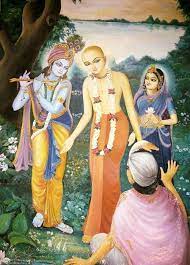
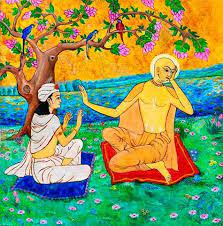
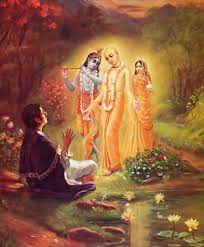
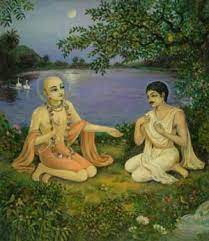
 Giriraj Swami read and spoke from Srimad-Bhagavatam 7.9.19.
Giriraj Swami read and spoke from Srimad-Bhagavatam 7.9.19. By Matthew Learning
By Matthew Learning By Kamala Priya Devi Dasi
By Kamala Priya Devi Dasi